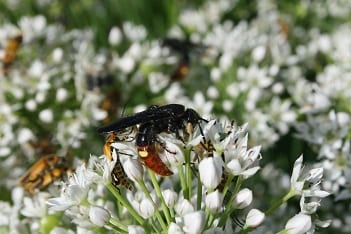–by Dr. Raymond Cloyd
Have you seen large wasp-like looking insects feeding on flowering plants such as wild onion, Allium spp and goldenrod, Solidago spp.? Well, this is Scolia dubia, which is a parasitoid of green June beetle, Cotinus nitida, larvae (grubs) located in the soil. Parasitoids are approximately 3/4-inches long with purple to black wings. The abdomen has red-brown markings and two very conspicuous yellow spots on both sides of the third abdominal segment (Figure 1). The parasitoids may be seen flying in a figure-eight pattern several inches above turfgrass infested with green June beetle larvae. The parasitoid can be seen feeding on goldenrod flowers along with goldenrod soldier beetle, Chauliognathus pennsylvanicus, adults (Figure 2) (see next article).
Fig 1. Adult Scolia dubia Feeding on Wild Onion Flower (Author–Raymond Cloyd, KSU).
Fig 2. Scolia dubia Adult Feeding on Goldenrod Flowers Along with Goldenrod Soldier Beetle Adults (A.–Raymond Cloyd, KSU)
Female parasitoids enter the burrow of a green June beetle larva, paralyze the larva by stinging it, and then attach an egg to the underside of the larva. After hatching, the parasitoid larva consumes the dead green June beetle larva. Scolia dubia overwinter as a pupa in a cocoon located at the bottom of the burrow and then emerge (eclose) later as an adult. Adult parasitoids typically emerge (eclose) in middle to late August and feed on flower pollen and nectar. These parasitoids, unlike cicada killer wasps, are not very aggressive and will only sting (at least the females) when handled or stepped on with bare feet.

